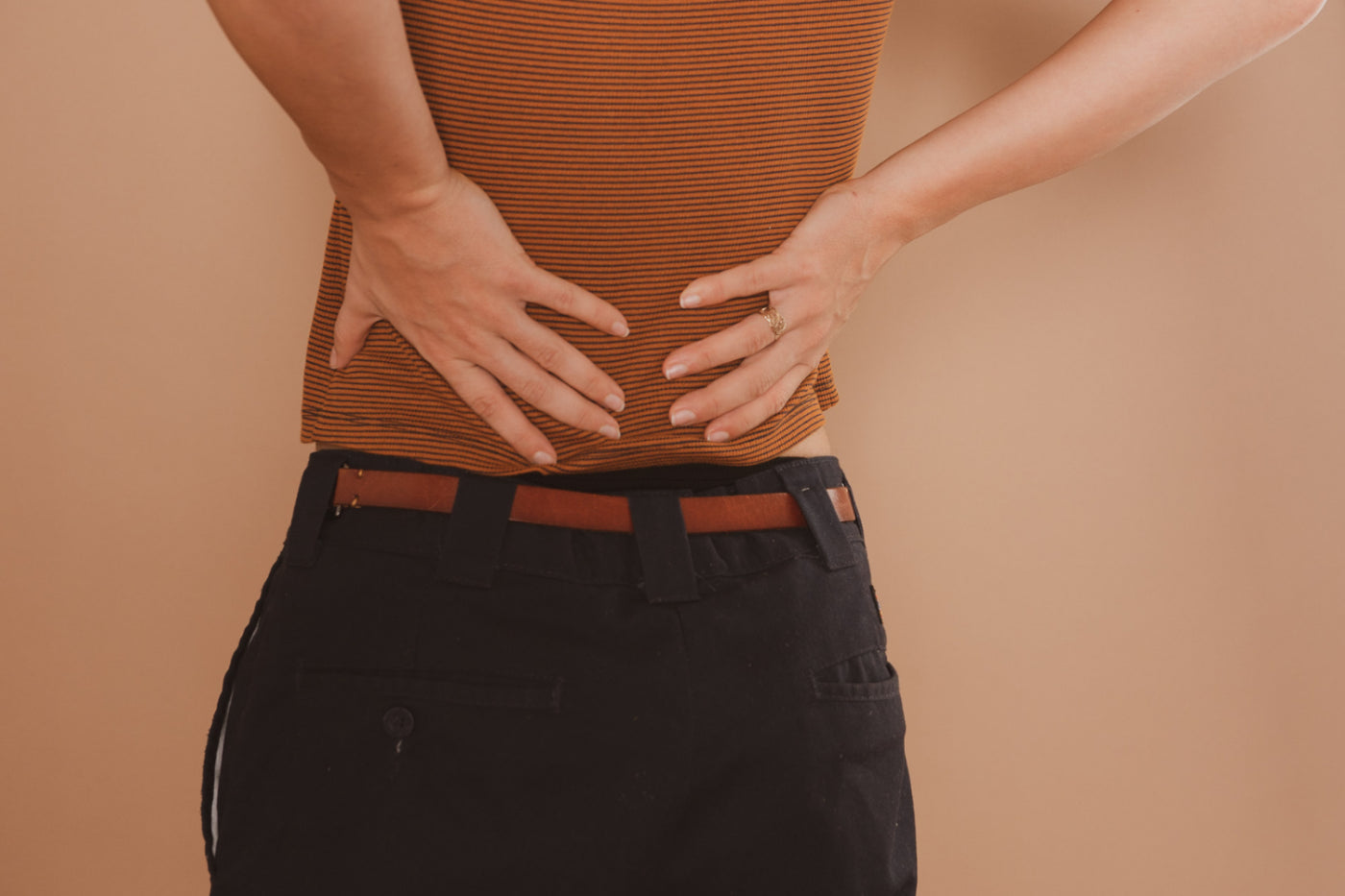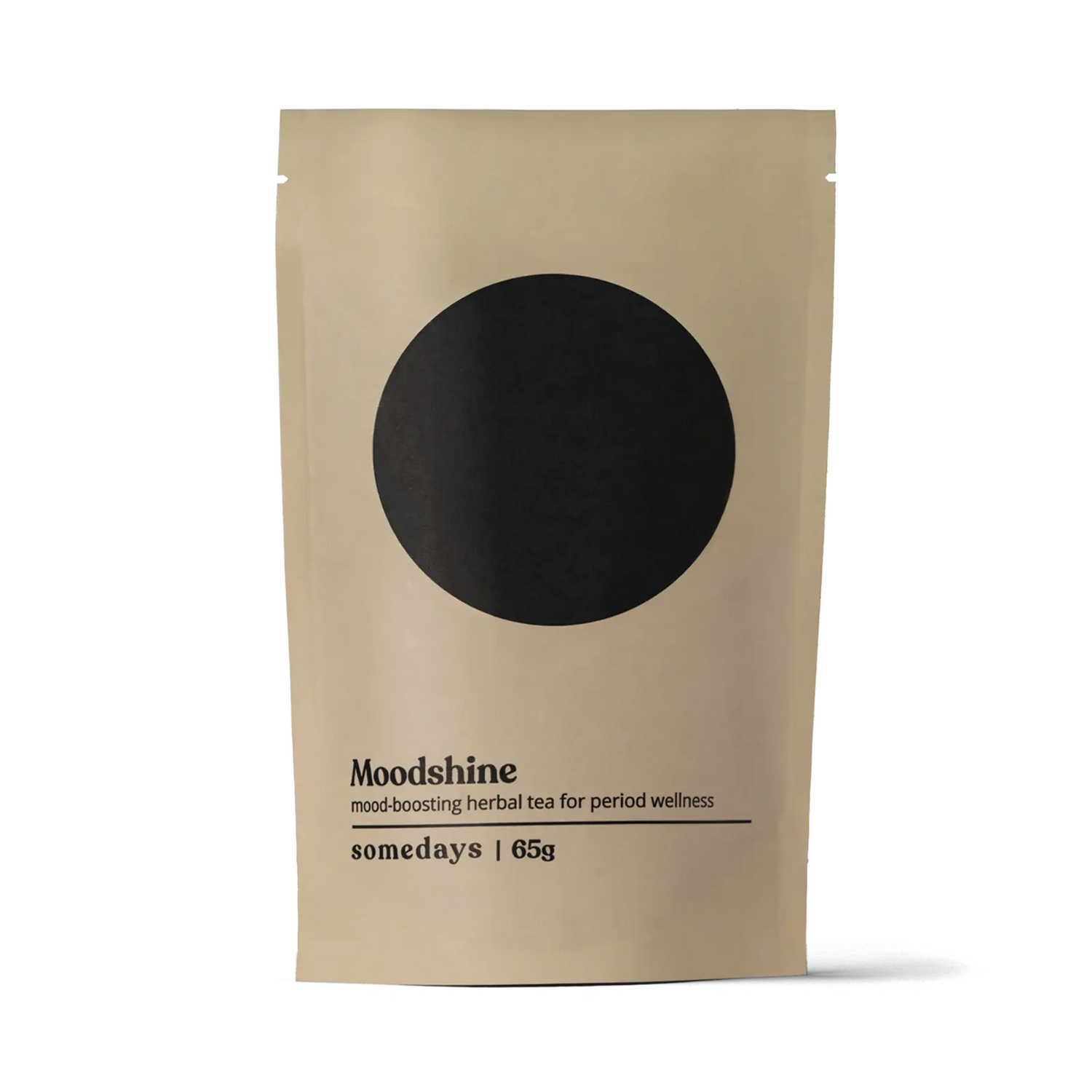What is Endometriosis and How To Treat It

Enter Your Email to Access Our 90% Accurate Endometriosis Assessment Tool
Period. Pain. Is. Not. Normal.
Let’s say that again, all together now.
Lux Perry, founder of somedays, had their first experience with debilitating period pain that landed them in the hospital at nine years old. For the next 20 years, they were passed from physician to physician, looking for answers and relief. “I have lived with chronic pain for most of my life. Before I was eventually diagnosed with endometriosis, I suffered from unexplained chronic pain my entire childhood.“
Lux was finally, formally diagnosed with endometriosis in 2021. Somedays is their response to the years they spent feeling invalidated and ignored by a system that told them their pain was normal — “ for a long time, I believed that chronic pain was something I would spend my entire life trying to escape. But it ended up being the thing that brought me home. To my body, to my truth, to entrepreneurship and eventually to founding somedays.”
Lux is dedicated to helping people find the relief and support they deserve by providing current research, education and the world’s first clinically validated online endometriosis risk assessment. Knowledge is power—read on to learn more about endometriosis or take the endometriosis risk assessment test HERE.
If you’re new here, welcome. Your pain is valid and we at somedays believe whole-heartedly that period pain is not normal.
Let’s start at the beginning. Period pain can be an indication of deeper, underlying conditions, such as endometriosis, PCOS, adenomyosis, fibroids and more. While some individuals may experience mild cramping during their menstrual cycle, severe pain and discomfort are not typical and may require medical attention. It's important to speak with a healthcare provider if you experience severe menstrual cramps or other symptoms that interfere with your daily life.
Like any condition that typically affects women or people with uteruses, the research on these issues leaves much to be desired. We realize that there is a lot of differing information spread across the internet on endometriosis — much of it from reputable sources that are sadly incorrect —which can be frustrating. This is why we’ve gone deep into the topic and collected the most up-to-date research, vetted by medical professionals and doctors to bring you as much recent evidence-based information on endometriosis, something near and dear to our hearts (and bodies) here at Somedays.
* Please note that there are many differing opinions and theories when it comes to endometriosis and the research/evidence is ever-evolving. If you would like us to update any of the information in this document please reach out to us.
What is Endometriosis?
We asked Dr. Allaire, who is a clinical Professor and of Gynaecologic Specialties at UBC Department of Obstetrics and Gynaecology and the Medical Director at BC Women’s Centre for Pelvic Pain and Endometriosis to explain the correct definition of endometriosis. She says that:
“the classic definition of endometriosis is the presence of endometrial-like tissue outside of the uterus. However endometriosis is more complex than that and is being recognized as a chronic systemic inflammatory condition.”
For those who have endometriosis, endometrial-like tissue can be found on the ovaries, pelvis, bladder, as well as the digestive or respiratory system. In fact, it has been found on almost every major organ of the body. These are called lesions and cause internal inflammation, leading to pain, cramping and other symptoms that can be debilitating. People with endometriosis often experience long-term (chronic) pain, especially during menstrual cycles. It affects an estimated 1 in 10 people with a uterus, which is approximately 176 million people worldwide — this number is most likely much higher, as it does not accurately account for transgender people, or those who struggle to get an accurate endometriosis diagnosis.
The symptoms can begin as early as menarche (first period) and may not be resolved by menopause if there is significant scar tissue. There is no definitive cause for endometriosis, but doctors propose a few potential reasons:
Transformed peritoneal cells.
Experts suggest that hormones or immune factors might help transform cells that line the inner side of the abdomen, called peritoneal cells, into cells that are like those that line the inside of the uterus.
Embryonic cell changes.
Hormones such as estrogen may transform embryonic cells — cells in the earliest stages of development — into endometrial-like cell growths during puberty.
Surgical scar complication.
Endometrial cells may attach to scar tissue from a cut made during surgery to the stomach area, such as a C-section.
Endometrial cell transport.
The blood vessels or tissue fluid system may move endometrial cells to other parts of the body.
Immune system condition.
A problem with the immune system may make the body unable to recognize and destroy endometriosis tissue.
Source: Mayo Clinic
Despite its prevalence, many people struggle to get a diagnosis and treatment plan as the symptoms of endometriosis are often normalized. At somedays, we strive to foster open dialogue around endometriosis to power awareness and advocacy.
Endometriosis Symptoms
For some, the pain associated with endometriosis can be so severe that it prevents them from engaging in daily activities such as working, visiting with family or friends, exercising, or even doing simple household chores. This pain can manifest in painful periods, painful ovulation, pain during or after sex, pelvic pain, and heavy bleeding.
It is possible, however, to have endometriosis and not have any noticeable symptoms such as pain but have trouble with fertility and pregnancy.
Due to the extent and severity of endometriosis, it can also lead to other bodily dysfunctions and is considered a Chronic Overlapping Pain Conditions (COPCs). COPCs are a cluster of conditions that affect mostly women and are thought to have underlying endocrine and inflammatory mechanisms. The diagnosis is made when two or more of these conditions are present: Endometriosis, irritable bowel syndrome (IBS), painful bladder syndrome/interstitial cystitis (PBS/IC), vulvodynia, fibromyalgia, chronic tension-type headaches or migraines, chronic low back pain, temporomandibular disorders, myalgic encephalomyelitis/chronic fatigue syndrome. Any combination of these conditions is possible and endometriosis is also often linked to mental dysfunctions such as generalized anxiety disorder and major depressive disorder
It is common for someone with endometriosis to also struggle with their mental health or other aspects of their physical health, and experience things such as brain fog, memory loss, intense fatigue, or digestion issues. Some other symptoms often experienced with endometriosis include:
- Uncomfortable, painful swelling and bloating, also called “endo belly”
- Diarrhea or constipation during menstruation
- Painful menstrual cramps
- Pain during sex
- Chronic pelvic pain
- Fatigue
- Painful urination or bowel movements
- Spotting and/or bleeding between periods
- Weight gain
Where Can Endometriosis Develop in the Body?
It typically is found on or around the reproductive organs, in the pelvis or abdomen.
- Fallopian tubes
- Ovaries
- Ligaments around the uterus, outside surface of the uterus
- Peritoneum (the lining of the abdomen and pelvis)
- Space between the uterus and the rectum/bladder
Less commonly, endometriosis can also be found:
- Bladder
- Vagina
- Cervix
- Intestines
- Stomach/abdomen
- Diaphragm
The Four Stages of Endometriosis
Classification systems for endometriosis play a crucial role in clarifying the disease, refining diagnostic techniques, and advancing treatments, while also fostering standardized communication among healthcare providers and researchers.
The American Society for Reproductive Medicine (ASRM) devised a widely employed staging system, dividing endometriosis into four stages based on lesion quantity and depth of infiltration: minimal (Stage 1), mild (Stage 2), moderate (Stage 3), and severe (Stage 4). This system also incorporates a point-based scoring method to quantify lesion severity, where a score of 15 or lower indicates minimal or mild disease, while a score of 16 or higher may suggest moderate or severe disease.
Stage 1 (1-5 points)
- Minimal
- Few superficial implants
Stage 2 (6 - 15 points)
- Mild
- More and deeper implants
Stage 3 (16 - 40 points)
- Moderate
- Many deep implants
- Small cysts on one or both ovaries
- Presence of filmy adhesions
Stage 4 (> 40 points)
- Severe
- Many deep implants
- Large cysts on one or both ovaries
- Many dense adhesions
However, the correlation between disease severity scores and symptomatology can be inconsistent. The Endometriosis Foundation of America proposes an alternative classification system, focusing on descriptive categories that consider anatomical location and infiltration depth.
EndoFound Endometriosis Classification
Category I: Peritoneal endometriosis
The most minimal form of endometriosis in which the peritoneum, the membrane that lines the abdomen, is infiltrated with endometriosis tissue.
Category II: Ovarian Endometriomas (Chocolate Cysts)
Endometriosis that is already established within the ovaries. These forms of ovarian cysts are of particular concern due to their risk of breaking and spreading endometriosis within the pelvic cavity.
Category III: Deep Infiltrating Endometriosis I (DIE I)
The first form of deep infiltrating endometriosis involves organs within the pelvic cavity. This can include the ovaries, rectum, uterus, and can significantly distort the anatomy of the pelvic organs.
Category IV: Deep Infiltrating Endometriosis II (DIE II)
The other more extreme form of DIE involves organs both within and outside the pelvic cavity. This can include the bowels, appendix, diaphragm, heart and lungs among others.
What Are the Risks & Causes of Endometriosis?
Endometriosis lesions pose a host of risks including (but not limited to) blocked fallopian tubes, cysts, inflammation and swelling, scar tissue that can lead to pelvic pain and infertility, and malfunction in the intestines and bladder. There is no exact known cause of endometriosis, but research suggests some possible causes:
- Endometriosis runs in families so it may be inherited genetically
- A compromised immune system
- An excess of the hormone, estrogen
- Surgeries in the abdominal area, like c-sections, can result in endometrial tissue being picked up and moved to different areas in the body
Aside from fertility issues, some studies indicate that endometriosis may also increase the risk of endometrial cancer and breast cancer. It’s important to note that endometriosis alone does not cause cancer.
Endometriosis Diagnosis
It can be very difficult to get an accurate endometriosis diagnosis. In order for doctors to determine what exactly is happening when someone is experiencing pelvic pain, they may perform pain mapping and sequencing through internal pelvic exams and ultrasounds to predict if there are lesions. This method of diagnosis is considered to be fairly accurate, however, the only way to determine if someone has endometriosis with 100% accuracy is by performing laparoscopic surgery.
Laparoscopic surgery is an invasive procedure where doctors operate on a patient to look for endometriosis lesions. If lesions are found they are removed via either ablation (burning) or excision (cutting).
Because menstrual and pelvic pain is typically misunderstood, devalued, and disregarded within medical systems, people with chronic menstrual pain often have to convince their physicians that their pain is severe enough to access these tests.
This leads to long lapses in time between the onset of symptoms to formal diagnosis for people with endometriosis-like symptoms. Globally, research shows that it takes people with periods an average of 7+ years to be properly diagnosed with endometriosis. In Canada specifically, it takes an average of 5.4 years for people to be diagnosed with endometriosis.
The diagnosis times extend for Black people, and other people of colour, due to medical racism and Eurocentric symptomatology. Black women in the United States of America are 50% less likely to be diagnosed with endometriosis.
This delay forces many people who think they might have endometriosis to self-diagnose and teach themselves how to manage their pain through online resources, created to make up for the gaps in the medical system. When it comes to endometriosis, you have to be your own advocate when talking to medical professionals. When speaking to your doctor, remember never to downplay your pain, be specific about your symptoms and chart them daily to give an accurate representation of your experience. Be persistent, ask questions and don’t be afraid to ask for a referral if you feel like you aren’t getting the care you need.
“A normalization of female pain, lack of knowledge among population and primary caregivers about symptoms, inadequate imaging and limited options for non-invasive testing contribute to delays in diagnosing and treating endometriosis” — Dr. Catherine Allaire, Medical Director, BC Women’s Centre for Pelvic Pain and Endometriosis
Endometriosis Treatment Options
Unfortunately, there is no official treatment for endometriosis, that said, there are many Western and natural options that can be used to manage symptoms. Taking a holistic and integrative approach to healing using these options is best for those struggling with endometriosis.
Holistic means treating the whole problem, considering the whole person rather than the symptoms in isolation. Integrative means utilizing a combination of different types of treatment (both medical and natural).
Physicians often recommend various over-the-counter (and sometimes prescription) anti-inflammatory drugs such as Ibuprofen, Tylenol, or Naproxen to decrease pain. For long-term improvement and pain reduction, healthcare providers often prescribe daily birth control pills, IUD insertions, or estrogen and progesterone medications to regulate hormone levels and cease ovulation.
Laparoscopy surgery is an option, especially if there is uncertainty about the diagnosis, lack of response, contraindication (ie. trying to get pregnant), an inability to tolerate medical therapies or invasive disease that is causing functional damage to organs (eg. bowel, ureter).
The drawback to medical solutions is that they are not cures and come with undesirable side effects. Because endometriosis is a chronic disease with a significant recurrence rate after even the best excisional surgery, the patient and their doctor should make a long-term management plan, with all treatment modalities considered and applied depending on where the patient is on their journey.
Combining medical treatments with lifestyle changes can have a more effective, sustainable impact. Many holistic lifestyle changes can help to decrease pain levels.
Studies have shown that eating an anti-inflammatory diet can help manage endometriosis pain by decreasing bodily inflammation and regulating hormone levels (such as reducing estrogen). Eating more vegetables, fruits, legumes, nuts, grains and seeds, and fewer highly processed, pre-packaged foods such as french fries, breads, treats and many animal products (especially dairy and red meat) has proven benefits.
Gentle exercises such as yoga or pilates, as well as simple aerobic exercises like walking or light jogging can be helpful. Treatments like physiotherapy, acupuncture, and counseling have also proven effective in decreasing symptoms caused by endometriosis.
Lastly, incorporating plant and herbal ingredients such as supplements, topical creams and tinctures, or herbal teas can prove to be effective in providing relief. We created our line of products to offer an all-natural solution to period pain—check out our Better Cycle Kit, Cramp Cream and Flaxseed Heatpad.
Living With Endometriosis
When left untreated, endometriosis - and the pain and infertility associated with it - will get worse over time. That’s why seeking treatment early is critical. However, those who decide to take menopausal hormone therapy may continue to experience pain past menopause.
Studies show that living with endometriosis not only impacts physiological functioning, it significantly compromises mental health. Endometriosis is associated with major depression and anxiety and has been shown to impair quality of life. It’s clear that living with chronic pain impacts more than just the body, and we recommend reaching out to your mental healthcare provider if you have access, for additional support.
In order to avoid a misdiagnosis, it’s important to note that other conditions present similarly to endometriosis. If a physician suspects you have one of these, they may delay proceeding with a treatment plan while they await confirmation. Here are a few “endo imposters” to keep in mind:
- Ovarian cysts
- Salpingitis (an infection in the fallopian tubes)
- Endometritis (inflammation of the uterine lining)
- Colitis
- Pelvic Adhesive Disease (scarring in the pelvis/ abdomen)
When it comes to your health, knowledge is power. Backed by evidence-based information and a drive for a pain-free life, we believe that better days are possible.
Many individuals experience symptoms of endometriosis, yet remain undiagnosed. If you suspect you might have endometriosis but haven't been diagnosed, it's essential to seek medical advice. Early detection and treatment can significantly improve quality of life. To better understand your symptoms and assess your risk, consider taking a free endometriosis assessment available HERE.
Join our Betterdays community - a weekly newsletter where we break down the latest (TLDR) news, research and breakthroughs related to your reproductive health—with a splash of humour to get you through the tough days.
Liz Hammond is a freelance copywriter who is working on a memoir about her experience with postpartum depression. She lives in Vancouver with her husband and son, and is a voracious reader and consumer of reality TV. She’s also a co-host of the podcast Not Your Mommy.
Contributions by: Dr. Allaire and Domunique Lashay
Previous Article All Articles Next Article
All ArticlesBetter Cycle Kit
A modern approach to traditional self-care practices, designed to support your body's natural rhythms and provide relief from period discomfort.
This comprehensive kit includes:
- Belly Jelly Castor Stick (25g): Apply to your abdomen to promote relaxation and well-being.
- Bamboo Belly Band: Secure the castor application comfortably in place.
- Flaxseed Heatpad with Custom Embroidered Cover and Carrying Case: Provides soothing warmth to ease discomfort.
Includes: Belly Jelly Castor Stick 25g, Bamboo Belly Band, Zip Pouch, Flaxseed Heatpad, Custom Embroidered Cover, Heatpad Carrying case
$132.00
ADD TO CART



